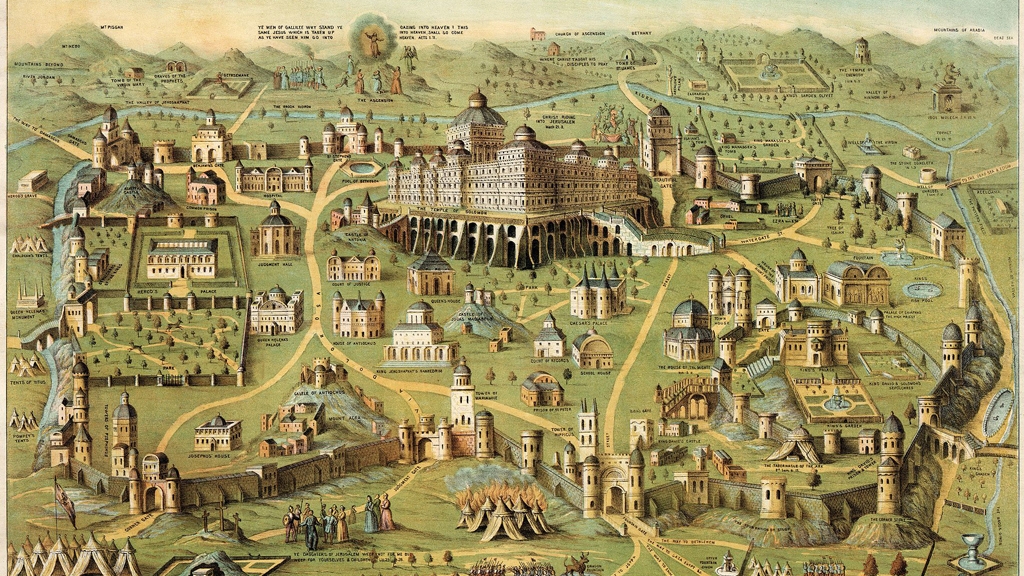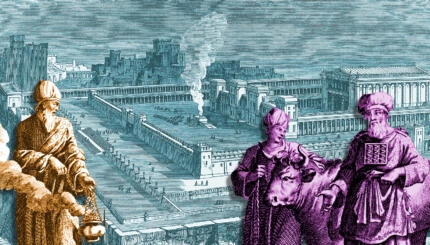Israelite religion shared a number of characteristics with the religions of neighboring peoples. Scholars have long noted parallels between the creation and flood myths of Mesopotamia and Egypt and those found in the Hebrew Bible. The Israelite god, YHWH, also shares many characteristics and epithets with the Canaanite gods El and Baal.
The Importance of Covenant
The Israelites’ relationship with YHWH, however, set them apart from their neighbors. This relationship was based on a covenant binding YHWH and Israel to one another through a series of obligations. Thus, the biblical authors depicted a direct correlation between the patriarchs’ (Abraham, Isaac, and Jacob) prosperity and their fidelity to YHWH. Similarly, the deliverance of the Israelites from Egypt into the Holy Land is cast as being conditional on the Israelites’ following YHWH’s precepts. It follows that the biblical authors attributed the misfortunes that befell the Israelites (e.g. plagues and military failures, etc.) to the Israelites’ failure to comply with terms of this covenant.
The First Temple
The establishment of the Temple under David and Solomon (c. 1000 BCE) marked a major development in Israelite religion. The Temple, intended to be the official focal point for Israelite religion replacing the family shrines and cultic places of earlier periods, served as a primary place for sacrifices, worship, and regular pilgrimages. Perhaps most importantly, the Temple served as a symbol of YHWH’s presence among the Israelites, and by extension, divine protection.
Despite this effort to centralize the Israelite cult, biblical and archaeological evidence indicates that traditional cultic sites and family shrines continued to exist throughout the monarchy (c. 1000–587 BCE).
With your help, My Jewish Learning can provide endless opportunities for learning, connection and discovery.
The biblical prophets played a special role in Israelite religion. They fervently condemned religious infidelities, including the worship of foreign gods. They were also very vocal in their intolerance of social injustice, especially abuses of power committed by Israelite elites. The eighth-century BCE prophet Isaiah went so far as to declare that religious practices, including sacrifice and observance of festivals, were meaningless as long as social injustices remained.
The Babylonian Exile
The Babylonian exile had a grave impact on Israelite religion. The Temple was destroyed, the “eternal” Davidic dynasty interrupted, and the people driven from the land YHWH had given them. Little is known about religious life during the exile except that solemn days were designated to mourn the loss of Israelite institutions. The prophets attempted to soothe the pain of these losses by promising a glorious restoration, the promise of which was never fully realized.
The Second Temple

The return from exile witnessed efforts to unify the Jews by the likes of Ezra and Nehemiah (early leaders of the Second Temple period) including the canonization of scripture and reaffirmation of the covenant with YHWH. Such measures, however, were countered by growing discontent, as evident from the apocalyptic writings of the period and the emergence of numerous sects.
The Pharisees and Sadducees were the two most prominent groups of the period. The Pharisees, the presumed predecessors to the rabbinic tradition, promoted incorporating religion into every aspect of life and generally rejected Hellenism. The Sadducees, with ties to the priesthood, maintained their religious identity, but were more open to Hellenistic culture. Other groups, such as the Essenes (who some scholars associate with the Dead Sea Scrolls) held more radical beliefs. The early Jewish Christians were yet another significant Jewish sect–not yet adherents of a separate religion.
The Second Temple’s Destruction and the Emergence of Rabbinic Judaism
The destruction of the Temple, which had served as the religious and political center for the Jewish people, presented a major challenge. The Jews survived this crisis by giving new prominence to institutions that played only minor roles during the Second Temple period. Synagogues absorbed the role of the Temple as places for worship and learning; prayer took the place of sacrifice; rabbis sought to replace priests as teachers and guardians over the law.
The rabbis’ ability to adapt biblical traditions–including dietary laws, observance of Shabbat and the festivals, and worship–for life in exile enabled Judaism to survive the transition beyond the Temple period, and ultimately to persevere throughout the ages. The Mishnah (a collection of law edited around the year 200 CE) and the Gemara (a commentary on the Mishnah, discussing its teachings and connecting it to the biblical text, compiled in approximately 500 CE), record opinions and discussions relevant to life in a world that no longer preserved Temple-based institutions and traditions.
Rabbinic authority, however, did not remain unchallenged. In addition to references to resistance in rabbinic writings, there are numerous amulets and incantation vessels attesting to the use of magic among the Jews of this period.
Shabbat
Pronounced: shuh-BAHT or shah-BAHT, Origin: Hebrew, the Sabbath, from sundown Friday to sundown Saturday.



